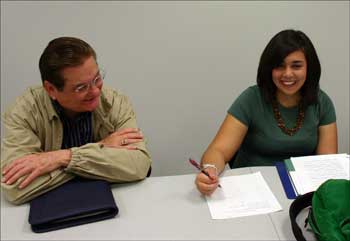The Arizona Board of Regents has approved budget plans by Northern Arizona University to initially invest about $6 million to expand health professions programs, thereby helping Arizona cope with significant shortages in the state’s health care workforce.
The Arizona Board of Regents last week approved NAU’s request to use $2.16 million this fiscal year from the Technology and Research Initiative Fund to expand NAU’s existing programs in physical therapy, nursing and possibly others. The TRIF money also would provide seed funding to consider developing other programs currently not offered in Arizona by a public university, including physician assistant and/or occupational therapy.
The TRIF funds would allow NAU to hire a director and necessary staff for the health professions initiative as well as allow rapid expansion of new laboratory and clinical spaces on the Flagstaff campus.
In addition, the regents approved NAU’s 2007-08 state budget request, which includes $4 million to invest in the personnel, buildings and equipment to establish new programs in the state in occupational therapy and physician assistant. NAU’s state budget request is preliminary and will undergo considerable review and revisions before its final approval by the governor in late spring.
The current number of annual graduates from Arizona programs in such fields as occupational therapy, physician assistant and medical technology is falling short of Arizona demand by as much as 86 percent, according to the U.S. Department of Commerce.
“This health professions expansion initiative meets the public agenda and an extraordinary state need,” said NAU President John Haeger, who noted the university had to turn away more than 500 students last year because of lack of space in existing health professions programs.
Haeger said the expansion of health professions programs will complement the medical and health program degrees offered by the University of Arizona and Arizona State University and the new UA College of Medicine in Phoenix.
The NAU president also told the regents that the health professions initiative will require long-term state support, student fee adjustments and contributions from NAU’s regular TRIF allocation. TRIF revenue is generated by a sales tax increase that was implemented in 2000 when voters approved Proposition 301 to support education.
In addition to the health professions expansion initiative, the regents also approved the use of another $2.16 million in 2006-07 TRIF funds for NAU to establish a stable presence in Maricopa County. The funds would cover an initial lease and support for a building on I-17 between Greenway and Bell roads. The building will consolidate all of NAU’s current operations on Third Street and the majority of its operations at Paradise Valley Community College.
Besides the $4 million for new and expanded health professions programs, NAU’s 2007-08 budget request also includes:
- $5 million to cover debt service for a proposed 200,000-square-foot, high-tech academic facility that would include the math, English, modern languages and philosophy departments as well as Distance Learning departments and programs
- $4 million for a faculty and staff retention competitiveness fund that would be in addition to any state employee pay plan package
- $3 million to enhance the learning environment on the Flagstaff campus and to support statewide expansion initiatives
- $1 million to increase the number of math and science teachers
- $1.5 million for the Ecological Restoration Institute to expand its operation
NAU has requested an additional $28.6 million in state funding for 2007-08, a 16 percent increase over last year.
In other action, the regents authorized NAU to plan a new master of science in engineering. This residential program would complement the existing tri-university master of engineering program that is predominantly distance-delivered. Initial program emphases would include natural resources and sustainable systems engineering, and advance design, materials and processes.
At its meeting on campus, the regents also approved the 2006 Annual Personnel Report for the university system, which compares faculty and staff salaries to peer institutions and other relevant labor markets. However, ABOR approval did not equate to endorsement.
“It’s a complete outrage how uncompetitive this situation is,” said Regent Anne Mariucci.
The report notes that while progress has been made with legislative appropriations in 2006, salaries still lack competitiveness. The projected unmet salary need for the three universities for fiscal year 2008 is about $109 million. NAU’s portion of this unmet need is $24 million.
“The problem at this point is virtually intractable,” Haeger said. He noted that even in its best budget year, NAU might have $7 million to $8 million in flexible budget dollars. “That’s far from the unmet need of $24 million.”
In calling for additional state support for salaries, Haeger said, “Faculty and staff are where the universities begin in terms of quality.”



